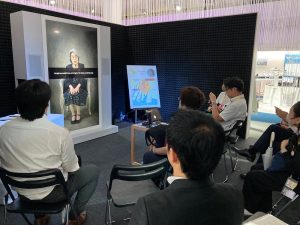実施日 : 2025年07月08日(火) - 09日(水)
Hiroshima Press Tour
投稿日 : 2025年06月11日
As there are already more applications for this press tour than there are positions available, we will be closing applications. Thank you for your understanding.
June 26, 2025
Hiroshima Press Tour
Tour Dates: Tuesday, July 8–Wednesday, July 9, 2025
[Topics]
- 1. 80 Years Since the Atomic Bombing: The Reality of the Aftermath
- 2. Passing on Memories of the Bombing to the Next Generation: Younger Generation Successors and the AI-based Hibakusha Testimony Simulator
- 3. Interview with Hiroshima’s Mayor: Sending the Message of the Spirit of Hiroshima to the World
[Tour Details]
On August 6, 1945, an atomic bomb was dropped on Hiroshima, killing many of its residents in an instant.
From a burnt wasteland, the city recovered after the war, and the people of Hiroshima have continued to call for the abolition of nuclear weapons and promote peace. In 2025, 80 years since the atomic bombing, the message from Hiroshima is even more significant. With tensions rising around the world, there are real concerns about the use of nuclear weapons.
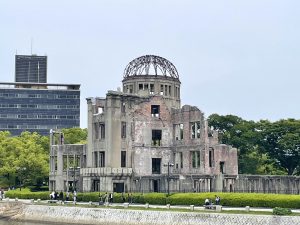 Amid this chaotic international situation, in 2024 Nihon Hidankyo (Japan Confederation of A- and H-Bomb Sufferers Organizations) received the Nobel Peace Prize. With this international recognition of the activities of hibakusha (atomic bomb survivors), the efforts of Japan, as the only country to have been atomic bombed in a war, are receiving renewed attention from around the world.
Amid this chaotic international situation, in 2024 Nihon Hidankyo (Japan Confederation of A- and H-Bomb Sufferers Organizations) received the Nobel Peace Prize. With this international recognition of the activities of hibakusha (atomic bomb survivors), the efforts of Japan, as the only country to have been atomic bombed in a war, are receiving renewed attention from around the world.
However, with hibakusha aging the number of people who can personally speak about the realities of the bombing is decreasing every year, and passing on those memories is an urgent issue.
In this situation, the City of Hiroshima is actively involved in cooperative initiatives with the public to communicate the realities of the atomic bombing to the next generation and share the “Spirit of Hiroshima” which strongly wishes for everlasting world peace and the abolition of nuclear weapons.
◆This tour will learn about the realities of the atomic bombing, hearing from hibakusha about their experiences and visiting the Hiroshima Peace Memorial Museum and the Atomic Bomb Dome. The tour will also cover projects to preserve memories for the future, such as having younger generations telling hibakushas’ stories and the development of a device to provide hibakusha testimonies using AI. There will also be an interview with the mayor. By meeting with representatives of the local government, residents, and companies, the tour will hear the message from Hiroshima 80 years after the atomic bombing.
1. 80 Years Since the Atomic Bombing: The Reality of the Aftermath
(1) Hiroshima Peace Memorial Museum
—Communicating the Horrors of the Atomic Bombing Through Pictures and Former Possessions of Victims
https://hpmmuseum.jp/?lang=eng
The Hiroshima Peace Memorial Museum exhibits personal belongings of the victims of the bombing, with pictures and other materials showing the horrors of the bombing, in order to communicate the realities of the damage of atomic bombs to later generations. The museum has exhibits including burned clothes and lunch boxes, pictures of the city just after the bombing, and testimonies by victims, showing visitors fragments of the lives stolen by the atomic bombing.
In 2019, the exhibits in the Main Building of the personal belongings of victims of the bombing and the horrors of the bombing were renovated to place the focus on the perspective of the victims of the bombing and the damage to humans. The exhibition order was also rearranged, so that visitors could face the realities of the atomic bombing even with just a short visit.
◆The tour will see the interior of the Hiroshima Peace Memorial Museum along with a briefing by its director, Mr. Yoshifumi Ishida, followed by an interview with Mr. Ishida.
◎Note: Please be aware there will still be various restrictions on filming/photography in the museum.
(2) Peace Memorial Park
—A Place to Wish for Peace
https://www.city.hiroshima.lg.jp/living/park-green/1005983/1026353/1003127.html
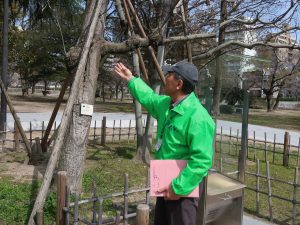
[Photo courtesy of Hiroshima Peace Culture Foundation]
Located in central Hiroshima City, the Peace Memorial Park established to honor the victims of the atomic bombing and pray for the realization of everlasting world peace. The park is home to the Atomic Bomb Dome, which remains as it was after the bombing; the Cenotaph for the A-bomb Victims, which contains registries of the names, age at the time of death, and death dates of victims of the atomic bomb; and the Children’s Peace Monument, which was built using donations from around Japan to commemorate the death of Sadako Sasaki, who folded origami cranes while battling leukemia.
With the goal of passing on the experiences of hibakusha, Hiroshima Peace Volunteers and Youth Peace Volunteers (high school and university students) act as guides to the park. These volunteers provide explanations in English, as well as Japanese, and the park provides visitors from Japan and abroad with an opportunity to think about peace.
(3) Atomic Bomb Dome
—With Special Permission Granted to Film/Photograph Inside the Dome
https://www.city.hiroshima.lg.jp/english/peace/1029869/index.html
Located in current Peace Memorial Park, it was completed in 1915 as a facility to display and sell prefectural specialties, and local residents appreciated its unique dome.
On August 6, 1945, the atomic bomb exploded nearby, approximately 160 meters southeast of the building, and the building was heavily damaged and burned. Everyone inside died. The Atmic Bomb Dome dome was inscribed on the UNESCO World Heritage List in December 1996, as historic evidence of the damage caused by the first ever atomic bombing, and as a symbol of wishes for everlasting peace and the abolition of nuclear weapons.
The Dome is maintained to keep it in the same state it was after the bombing. The site includes pieces of debris that were part of the building, and in the interior you can see rebar that was exposed by the blast, as the damage from the bombing remains visible to this day. The condition of the Dome shows visitors the horrors of the atomic bombing, and how valuable peace is.
◆A Hiroshima Peace Volunteer will guide the tour around the Hiroshima Peace Memorial Park. Afterwards, the tour will visit the Atomic Bomb Dome and, with special permission, be allowed to film/photograph it from the interior. The tour will also hear from the Youth Peace Volunteers about their activities.
(4) Hiroshima Municipal Honkawa Elementary School Peace Museum
—A Second-generation Hibakusha Graduate Describing the Experiences of Students 80 Years Ago
https://peace-tourism.com/en/story/entry-131.html
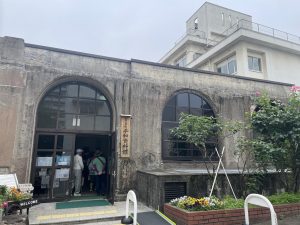 Hiroshima Municipal Honkawa Elementary School is located approximately 410 meters from the hypocenter of the explosion, and around 400 students and 10 teachers lost their lives in the August 6, 1945 atomic bombing. Made from reinforced concrete, the exterior of the school building remained while the interior burned, and after the bombing it was used as a relief station. Part of the school building and its basement were preserved, and in May 1988 opened as the Honkawa Elementary School Peace Museum. Possessions of the victims collected from the ruins are displayed there. The school is also thought to be the model for Honkawa National School, the school attended by the main character of the manga Barefoot Gen.
Hiroshima Municipal Honkawa Elementary School is located approximately 410 meters from the hypocenter of the explosion, and around 400 students and 10 teachers lost their lives in the August 6, 1945 atomic bombing. Made from reinforced concrete, the exterior of the school building remained while the interior burned, and after the bombing it was used as a relief station. Part of the school building and its basement were preserved, and in May 1988 opened as the Honkawa Elementary School Peace Museum. Possessions of the victims collected from the ruins are displayed there. The school is also thought to be the model for Honkawa National School, the school attended by the main character of the manga Barefoot Gen.
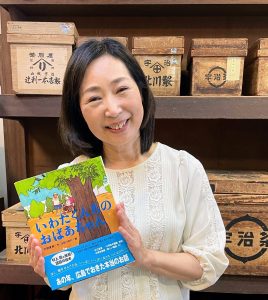
[Photo courtesy of Ms. Miho Iwata]
Second-generation hibakusha Ms. Miho Iwata acts as a volunteer guide at the Peace Museum, where she tells visitors of the experiences of her mother, Ms. Chizuko Wataoka, who was 16 years old at the time of the bombing and lost five of her family members. Iwata’s Grandma (Iwata-kun-chi no Obaachan), a picture book based on Ms. Chizuko Wataoka, was selected for use as part of Hiroshima City’s peace curriculum in 2023.
◆The tour will visit the Hiroshima Municipal Honkawa Elementary School Peace Museum, and hear from volunteer guide Ms. Miho Iwata while touring the museum.
(1) Atomic bomb survivor testimony & The Training Program for A-bomb Legacy Successors
—Volunteers listening to the stories of hibakusha and passing them on to the next generation
https://www.city.hiroshima.lg.jp/atomicbomb-peace/fukko/1021099/1015041.html
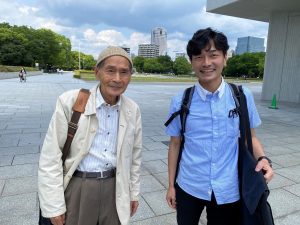
Mr. Fumiaki Kajiya and Mr. Haruki Okimoto [Photo courtesy of Mr. Haruki Okimoto]
Since FY2012, the City of Hiroshima has been carrying out a project to train A-bomb Legacy Successors etc. in order to pass on the experiences and wishes for peace of hibakusha (“witnesses”) to the next generation.
In this project, those who applied to the program listen to the stories of witnesses to learn about their experiences, along with approximately two years of lectures, meetings with witnesses, and practice talks, to increase their understanding of the realities of the bombing and the experiences of witnesses. After finishing the training course, they are recognized as A-bomb Legacy Successors (“successors”), and give talks to students on school trips and overseas visitors at locations such as the Peace Memorial Museum. As of April 2025, there are 239 active successors, and with the rising average age of witnesses, their role is growing more important.
◆The tour will first hear from Mr. Fumiaki Kajiya, a witness, about his experiences. Next, Mr. Tomofumi Okagawa, a member of the International Peace Promotion Department of the Citizens Affairs Bureau of the City of Hiroshima working on the Training Program for A-bomb Legacy Successors, will give an overview of the program. The tour will then hear from Mr. Haruki Okimoto, a successor to whom the experiences and wishes for peace of a witness have been passed on about what led to him becoming involved in this program.
(2) AI-based Hibakusha Testimony Simulator
—Preparing for an Age Without Hibakusha, a New Initiative to Pass on Memories
https://www.nhk.or.jp/hiroshima/hibaku75/taiwa/
In order to prepare for the near future when there are no more hibakusha, NHK Hiroshima Broadcasting Station has developed a Hibakusha Testimony Simulator using AI. After someone verbally asks a question to video of a hibakusha, the AI analyzes the question and plays an appropriate response from the prerecorded videos. This system does not use generative AI to create new responses, only using keywords from the question to select and play an appropriate video testimony from the database. The biggest difference from existing video testimonies is that it creates the experience of a dialogue between the hibakusha and the person asking the questions.
Ms. Yoshiko Kajimoto, a hibakusha, was recorded responding to approximately 900 questions over five days, which she did due to her strong desire to pass on her tragic experiences to later generations. People who have used this system have said that it feels like engaging in a real conversation, and gave a real sense of Ms. Kajimoto’s experiences in the atomic bombing. The system can respond to questions in English to some extent, and at the 2023 G7 Summit in Hiroshima foreign media were able to experience using this system.
Currently, the City of Hiroshima is carrying out a project to film testimonies by five other hibakusha and prepare them for use by the system.
◆The tour will hear an explanation of the Hibakusha Testimony Simulator from NHK staff who were involved in its development, and speak with Ms. Yoshiko Kajimoto, who assisted in its development. There will also be a demonstration of the system.
(3) Otafuku Sauce Co., Ltd. & Rebooting Memories
—AI Colorization of Black and White Photos to Pass On the History of the War and Reconstruction
https://www.otafukusauce.com/e/
https://www.instagram.com/anju_niwata/
After the war, when people were trying to survive on the little aid that was provided amidst a serious food shortage, food stalls began selling a simple okonomiyaki that was made from frying a batter consisting of flour and water, with vegetables added on top before folding it in half. Evolving over the years, okonomiyaki became popular in Hiroshima as a symbol of its reconstruction, and is now considered Hiroshima’s soul food.
Otafuku Sauce Co., Ltd. was closely involved in building this food culture. Sasaki Shoten, the predecessor to Otafuku Sauce, was established in 1922 and sold sake and soy sauce, and began producing vinegar in 1938, but its storefront was destroyed by the atomic bombing in 1945. Restarting the business from the ruins, the company began making Worcestershire sauce. Later, they developed okonomiyaki sauce by making a thicker version of Worcestershire sauce. Today, the business has expanded not only throughout Japan, but also overseas.
The Rebooting Memories initiative exists to record the war and reconstruction, and pass on the wishes of the people who experienced them to the future. This initiative was started in 2017 by Ms. Anju Niwata, a reporter and director for Hiroshima Television Corporation who is from Hiroshima, when she was still in high school. Using AI, she colorized black and white photos from before the bombing of Hiroshima and the people living there, and then corrected the colors by checking wartime materials and through discussions with people who experienced the war. Through careful efforts, she replicated the scenery of what it was like to live in Hiroshima at the time, rebooting these memories.
The initiative colorized a family picture of Mr. Yasufumi Sasaki, who was six years old at the time of the bombing and is the senior adviser of Otafuku Sauce, as the company and Hiroshima share a common history.
◆The tour will hear from Ms. Anju Niwata about the Rebooting Memories initiative (photos will be shown via projector). The tour will also hear from Mr. Yasufumi Sasaki, senior adviser of Otafuku Sauce Co., Ltd., about the history of okonomiyaki after the war and the company’s development, as well as his wishes to pass on memories to the next generation. The tour will also visit OKOSTA, a cooking studio run by Otafuku Sauce, where the journalists will be able to eat okonomiyaki they make themselves for lunch.
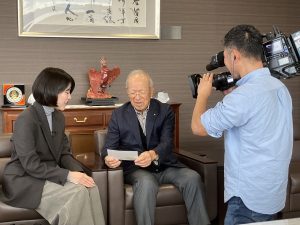
Mr. Sasaki talking about the photo, being interviewed by Ms. Niwata [Photo courtesy of Otafuku Sauce Co., Ltd.]
Interview with Hiroshima Mayor Kazumi Matsui—Initiatives for Peace by the City of Hiroshima
https://www.city.hiroshima.lg.jp/english/1037042.html
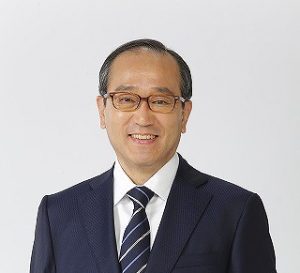
[Photo courtesy of the City of Hiroshima]
In 2025, a historic milestone of 80 years since the atomic bombing, the City of Hiroshima is enhancing its efforts to reach out domestically and internationally in order to pass on the experiences of hibakusha and wishes for peace to the future.
With international tensions over the risk of nuclear weapons rising, Mayor Kazumi Matsui would like the younger generations who support civil society to engage in efforts to promote the culture of peace and expand their activities, demonstrating his hopes for the next generation.
On this 80th anniversary of the bombing, the City of Hiroshima has positioned “promotion of the culture of peace” as a new pillar in addition to “honoring the victims of the bombing and support for hibakusha” and is carrying out commemorative events based on six themes including “conveying the will for peace through the city landscape”, and “allowing citizens to understand the realities of the atomic bombing on a personal level”. Through these initiatives, the City of Hiroshima is fulfilling its duty as an atomic-bombed city and working towards peace.
◆The tour will listen to a briefing by Mr. Ryoji Hasebe, a member of the International Peace Promotion Department of the Citizens Affairs Bureau of the City of Hiroshima, about the city’s initiatives on the 80th anniversary of the bombing, and try a multilingual virtual reality (VR) experience including VR video of the damage from the atomic bombing. This will be followed by an interview with Mayor Kazumi Matsui.
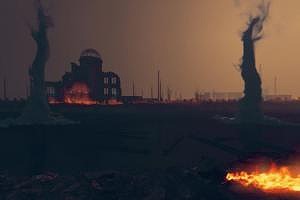 |
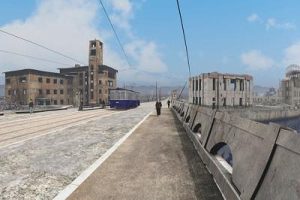 |
Screenshots of VR experience of the atomic bombing
[Photo courtesy of Peace Park Tour VR]
[Tour Itinerary]
- 1. Dates:
Tuesday, July 8–Wednesday, July 9, 2025
- 2. Schedule:
*The schedule may change without notice.
[Day 1: Tuesday, July 8]
|
07:25-08:45 |
Haneda Airport→Hiroshima Airport (JAL 253) |
|
10:30-11:30 |
Peace Memorial Park |
|
11:40-12:40 |
Atomic Bomb Dome (including interior tour) |
|
13:00-13:50 |
Lunch |
|
14:00-15:30 |
Hiroshima Peace Memorial Museum |
|
15:45-17:45 |
Atomic bomb survivor testimony(accompanied by A-bomb Legacy Successor), Interview with Hibakusha and A-bomb Legacy Successor |
|
18:00 |
Arrive at hotel (in Hiroshima City) |
[Day 2: Wednesday, July 9]
|
08:45 |
Leave hotel |
|
09:00-10:40 |
Hibakusha Testimony Simulator, Interview with Hibakusha Who Assisted in the Development of the Simulator |
|
11:00-12:20 |
Otafuku Sauce Co., Ltd. & Rebooting Memories |
|
12:30-14:00 |
Lunch |
|
14:20-15:35 |
Hiroshima Municipal Honkawa Elementary School Peace Museum |
|
16:00-16:45 |
Briefing by City Official on City of Hiroshima Initiatives for Peace |
|
17:00-18:00 |
Interview with Mayor Kazumi Matsui |
|
20:30-22:00 |
Hiroshima Airport→Haneda Airport (JAL 266) |
- 3. Qualification: Bearer of the Ministry of Foreign Affairs of Japan Press Registration Card (in principle)
- 4. Cost: 15,000 yen per person, including transportation, accommodation (breakfast included), and lunches (for both days)
*Information on payment and cancellation fee will be provided to participants.
*Participants will be required to pay their own transportation costs to the meeting place before the tour, and after the tour ends
- 5. Participants: Limited to 10 participants.
(Only one reporter or one photographer from each company, but two participants from each TV team will be acceptable.)
*Participants will be determined by the tour organizer.
6.Please be sure to confirm and agree to the following before applying
6-1. Basic Information
(1) This tour is organized by The City of Hiroshima and run by the FPCJ.
(2) The schedule is subject to change without notice.
(3) This tour will require participants to bear a part of the cost but is not a profit-making venture.
(4) The City of Hiroshima and the FPCJ take no responsibility for any accidents, injuries, illness, or other problems which occur during the tour.
(5) There may be some restrictions on photographing and filming at the tour sites. Please follow the instructions of the staff in charge.
(6) This press tour is intended to provide opportunities for news coverage. We request that all participants send a copy of the content of their coverage (article, video, or audio in the case of radio) to The City of Hiroshima through the FPCJ after their reports are published or aired. When your report is in a language other than English or Japanese, we also ask you to provide a summary in English or Japanese. By submitting your application, we assume that you have agreed to these conditions.
6-2.Handling of Personal Information
When applying for the tour, you agree to the below:
*Regarding the handling of personal information, the press tour organizers and operators will respect Japan’s Act on the Protection of Personal Information and all other laws and guidelines on the protection of personal information and handle personal information appropriately.
(1) The tour operators will, when there is a need to do so for the press tour, provide the personal information provided when applying (organization name, personal name, etc.) to other parties in the following cases:
-To arrange travel or insurance through travel agencies (Information provided to: Travel agencies, accommodation operators, transportation operators, insurance companies)
-To ensure smooth operations during the tour (Information provided to: Interpreters, stops on the tour, interviewees)
(2) The tour operators, to ensure smooth operation of the tour, will share the personal names and organization names of applicants with the tour organizers.
6-3.Recordings by Press Tour Organizers or Operators During the Tour
When applying for the tour, you agree to the below:
(1) For the record-keeping purposes, the tour operators may film or photograph the tour while it is happening. The copyright holders for these photos or videos will be the tour organizers.
(2) Photos, videos, or articles of the press tour may be uploaded to websites or social media accounts operated by the organizers or operators.
(3) The likeness or voice of participants may appear in the abovementioned photos or videos, but you agree to their use by the organizers or operators.
7. FPCJ Contacts:
Watanabe (Ms.), Yoshida (Ms.), Mizutani (Ms.)
Media Relations Division
(Tel: 03-3501-3405, E-mail: ma@fpcjpn.or.jp)
◆ When applying for the tour, you agree to the following conditions ◆
- Press tours have participants from multiple media organizations, and interviews, filming, and photographing are generally carried out jointly. There is no guarantee that you will be able to perform individual interviews or take individual videos at any of the stops on the tour.
- You must follow the instructions of the tour organizers and operators regarding the tour schedule, timing, and restrictions on taking videos or photos. If you refuse to follow instructions, you will no longer be allowed to participate in the press tour from that point on.
- Please ensure you do not include any information (including images, video, and audio) in your reporting that could make it possible to identify the other journalists participating in the press tour or the organizations they work for. If you would like to use such information in your reporting, confirm directly with the other journalist in advance and receive their permission. Please provide the same courtesy to staff accompanying the press tour as well.


